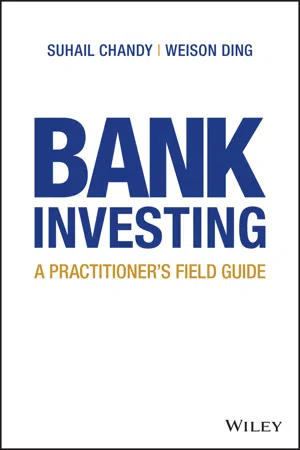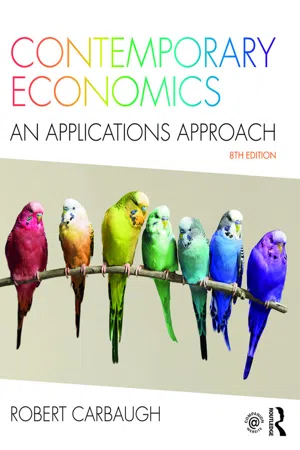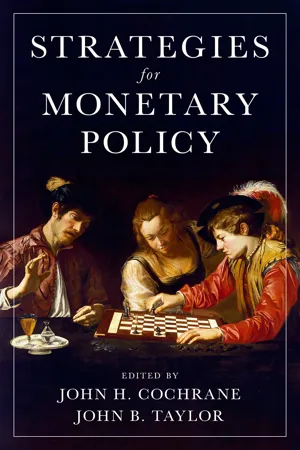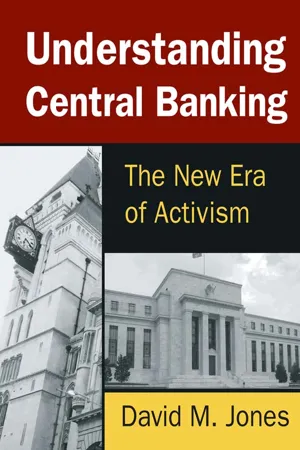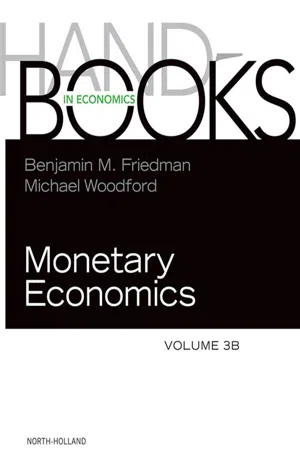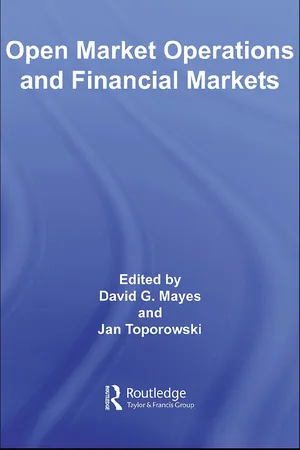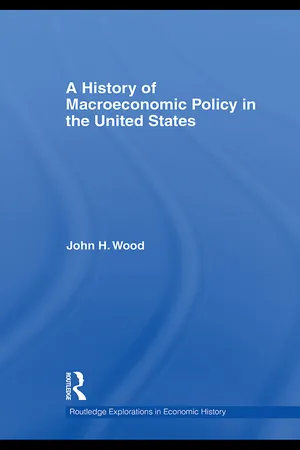Economics
Federal Funds Rate
The Federal Funds Rate is the interest rate at which depository institutions lend reserve balances to other depository institutions overnight on an uncollateralized basis. It is set by the Federal Open Market Committee (FOMC) and serves as a key tool for the Federal Reserve to influence monetary policy and control the money supply. Changes in the federal funds rate can have significant impacts on the broader economy.
Written by Perlego with AI-assistance
Related key terms
9 Key excerpts on "Federal Funds Rate"
- eBook - ePub
Bank Investing
A Practitioner's Field Guide
- Suhail Chandy, Weison Ding(Authors)
- 2021(Publication Date)
- Wiley(Publisher)
The Fed Funds Rate is perhaps the highest profile tool at the FOMC's disposal. Indeed, when looking at the policy statements put out by the FOMC, the fed funds rate target will be the first policy metric provided. This rate represents the rate at which depositories will lend their reserve balances (i.e., balances held at the Federal Reserve) to other depositories on an overnight and uncollateralized basis in order for the borrowing bank to fulfill reserve requirements. An increase in the fed funds rate represents a tightening of monetary policy, as it makes credit incrementally more expensive, while the converse is true for a decrease in the fed funds rate.An important aspect is that the federal funds market is very much a market influenced by market forces, and is expressed as a target with a 25-bps range. The Federal Reserve works hard to influence this market to reach its proposed target through various means including open market operations by the trading desk of the Federal Reserve Bank of New York. In this case, open market operations usually refer to overnight repos (adds liquidity if fed funds are too high) and reverse repos (removes liquidity if fed funds are too low) of Treasuries, agency debt, and mortgage-backed securities. Setting the interest on reserves is another tool in the Fed's pocket that we go into later. Generally, when there are excess reserves in the system, the interest on reserves is used to manipulate effective fed funds; when there is a shortage of cash, repo operations are effective.Once upon a time, the fed funds market was a good deal larger than what it is today. Pre-crisis, the interbank market was robust, and the largest suppliers and demanders of fed funds were the domestic commercial banks. A couple of drivers caused a dramatic shrinkage in the size of the fed funds market (Exhibit 7.4 ). One, the Fed purchased vast amounts of securities in the open market (more on that later), which flooded the entire banking system with excess liquidity. Banks held so much in reserves that the demand for fed funds declined. Two, the Fed started paying interest to banks on funds that were held in their reserve accounts, giving banks an alternate option to earn money on their reserves and thus decreasing the supply - No longer available |Learn more
Contemporary Economics
An Applications Approach
- Robert Carbaugh(Author)
- 2016(Publication Date)
- Routledge(Publisher)
federal funds market. Banks with surplus balances in their accounts transfer reserves to those needing to boost their balances.Typically, a federal funds transaction takes the form of an overnight loan. Arrangements are agreed upon by telephone between the lending bank and the borrowing bank and confirmed later by mail. The actual transfer of the reserves is normally accomplished by a phone call from the lending bank to the Federal Reserve Bank, instructing the latter to transfer the agreed-upon amount from its reserve account to that of the borrower. Generally, the Federal Reserve Bank will reverse the transaction on the following day.The Federal Reserve focuses monetary policy on the interest rate that it can best influence: the Federal Funds Rate. The Federal Reserve targets the Federal Funds Rate by controlling the amount of reserves supplied to the federal funds market. For example, an increase in the amount of reserves supplied to the federal funds market causes the funds rate to fall; a decrease in the supply of reserves raises that rate. Indeed, the Federal Funds Rate closely reflects the basic supply and demand conditions in the market for bank reserves that are influenced by the Fed’s monetary policies. Therefore, analysts pay close attention to the Federal Funds Rate for signals of change in monetary policy.Between meetings, the various members of the FOMC stay in touch through written and electronic correspondence. Moreover, an FOMC member talks daily with the Federal Reserve Bank of New York, which carries out the buying and selling of government securities. Telephone meetings of the entire FOMC may be called on very short notice, if necessary, and any member is free to object at any time to the manner in which the New York Federal Reserve Bank is carrying out the instructions of the FOMC. - eBook - ePub
- John H. Cochrane, John B. Taylor(Authors)
- 2020(Publication Date)
- Hoover Institution Press(Publisher)
Under our fiat money system, this institutional arrangement is embodied by the Federal Reserve. It is up to the Fed to conduct monetary policy in a way that pins down the aggregate nominal price level. The Fed achieves this goal by exercising its monopoly control over the supply of base money: currency plus bank reserves.Today, as before the crisis, the Fed implements monetary policy by targeting the Federal Funds Rate. The Federal Funds Rate, however, is a market rate of interest, charged by one bank to another on a very short-term loan of reserves. The Fed does not set the funds rate directly. Instead, the Fed’s operating procedures must link the Federal Funds Rate, which the Fed can only influence, to the monetary base, which the Fed can precisely control.Before the financial crisis of 2007– 2008, the link between the funds rate and the supply of base money was more immediate and therefore more obvious. Whenever the Fed wanted to lower its target for the funds rate, it conducted an open market purchase, buying US Treasury securities to inject new reserves into the banking system. The increased supply of bank reserves put downward pressure on the equilibrium funds rate, moving it lower in line with the new target. Conversely, whenever the Fed wanted to raise its target for the funds rate, it conducted an open market sale of US Treasury securities to drain reserves from the banking system and put upward pressure on the funds rate.Since December 2015, however, the Fed has gradually lifted its Federal Funds Rate target off its zero lower bound using a floor system. Under this floor system, the Fed uses its newly granted ability to pay interest on reserves to manipulate the Federal Funds Rate, without having to conduct open market operations right away. By raising the interest rates paid to banks on reserves and nonbank financial intermediaries on reserve repurchase agreements, the Fed has successfully moved the Federal Funds Rate up in lockstep. And, presumably, when the next easing cycle begins, the Fed will lower the interest rates on reserves and reverse repurchase agreements to bring the Federal Funds Rate back down. - eBook - ePub
Understanding Central Banking
The New Era of Activism
- David Jones(Author)
- 2014(Publication Date)
- Routledge(Publisher)
In fighting the credit crisis, the Bernanke Fed employed all the weapons at its command, including the use of communications to try to shape market interest rate expectations. Specifically, Fed officials sought to provide in their post-FOMC meeting policy statements additional forward guidance on the possible course of their key policy interest rate, starting in March 2009, and continuing until its modification on August 9, 2011. For example, the Fed used “extended period” language to try to manage market interest rate expectations. Notably, the statement that the FOMC anticipates that “economic conditions are likely to warrant exceptionally low levels of the Federal Funds Rate for an extended period” represented an effort by Fed officials to convince market participants that there would be an unusually prolonged period of extremely low short-term interest rates, in turn, portending lower longer-term interest rates than otherwise would have been the case. By common consensus, the “extended period” language applied to the next two or three FOMC meetings. On August 9, 2011, however, Fed policymakers dramatically lengthened the duration of the “extended period” to last until mid-2013.Taking a more traditional approach, the Taylor Rule, named after Stanford University economics professor John Taylor, calls on Fed policymakers to adjust their Federal Funds Rate target according to deviations from their dual objectives. For example, in response to each percentage point increase in the inflation rate above the Fed’s formal inflation target of 2 percent, the monetary authorities might increase their Federal Funds Rate target by 150 basis points. Conversely, when economic conditions are weakening, the Taylor rule calls for Fed officials to cut their funds rate target by 50 basis points in response to each percentage point decline in the actual level of output relative to the potential level of output at full employment. While there is no evidence that Fed officials follow the Taylor Rule in any rigorous or dutiful manner, former Fed governor Laurence Meyer has observed that it is still a useful guideline; see his book A Term at the Fed: An Insider’s View (2004).Other traditional Fed policy instruments include the discount rate, which, as already noted, was tied to the Federal Funds Rate at a penalty margin of 100 basis points in January 2003, but in response to the credit crisis was trimmed to a penalty margin of only 25 basis points. In February 2010, the Federal Reserve Board reestablished a 50 basis point spread between the discount rate and the upper end of the Fed’s zero to .25 percent target range for the Federal Funds Rate. The Fed also can use changes in reserve requirements as a policy instrument, but this is not employed frequently. An increase in the reserve requirement ratio reduces the limit for the maximum expansion of credit and deposits for the banking system for every additional dollar of reserves injected by the Fed. Conversely, a reduction in the reserve requirement ratio increases the limit for the maximum expansion of credit and deposits for the banking system for every additional dollar of reserves injected by the Fed. In addition, Fed communications policy might be considered a policy instrument, but it remains a work in progress. Finally, in fighting the Great Credit Crisis of 2007–2009, Fed officials, after lowering their “conventional” nominal Federal Funds Rate target to its lower bound of zero in December 2008, had to resort to using the Fed’s balance sheet as a policy instrument as they engaged in “unconventional,” large-scale purchases of longer-term securities. - eBook - ePub
Money, Banking, and Financial Markets
A Modern Introduction to Macroeconomics
- Dale K. Cline, Sandeep Mazumder(Authors)
- 2022(Publication Date)
- Routledge(Publisher)
Whenever the Fed begins to taper QE actions, talk of unwinding its bond purchases invariably occurs. Some believe that it will lead to economic instability or inflation. Since we understand that, because loan creation and the money supply is not affected by the size of the banking system’s reserve pool, we also understand that tapering QE will not lead to inflation. However, the markets may react to perceived changes in Fed policy and that may lead to instability. Therefore, the Fed must use caution and employ various tools to control the Fed funds rate as it alters its program. The interest paid on excess reserves allows the Fed to control the rate more accurately and quickly. Effectively serving as the lower boundary, the interest rate paid on reserves serves makes it easier to fine tune the rate, providing the ability to make adjustments without changing the levels of reserves.Velocity and other economic indicators
Economists define the money supply in terms of layers which build successively upon each other, moving from the most liquid to the least. The most-narrow layer, called the monetary base, includes actual cash in circulation and reserve accounts at the central bank, while the broad category of M3 encompasses larger, longer-term deposits, including institutional funds. M2 includes all notes and coins in circulation, cash equivalents and cash accounts except for time deposits of $100,000 or more, so it is fairly representative of the currency available to us to carry out our daily activities. But why does keeping a measure of the money supply matter? Well, many economists believe that the size of our money supply can be used as one guide to understanding and predicting both short-term economic variables as well as longer-term movements such as inflation, helping Fed officials to determine the appropriate course of action in terms of monetary policy.To view the money supply as an economic indicator, one must recognize that it should be expressed in terms of its relationship to other economic measures. For example, based on U.S. quarterly data from 1981 to 2019, M2 multiplied by approximately 1.8 equals the Gross Domestic Product (GDP), with GDP being defined as the total output of goods and services for, typically, a 1-year period. Figure 5.4 - eBook - ePub
- Rousseas(Author)
- 2016(Publication Date)
- Routledge(Publisher)
The revenues of a bank are largely derived from the "prices" charged against bank loans, or the pattern of interest rates, and the interest income from their holdings of short-term investments (Treasury bills—TBs). The interest rates, or prices, of loans are determined by a markup over the "cost of funds" determined by the degree of monopoly or the profit margin of the bank. The equivalent of "excess capacity" in the banking system can be viewed as the excess reserves banks hold and their holdings of such secondary reserves as highly liquid TBs—which can be quickly converted to loan assets virtually on demand either by refusing the Treasury's rollover, or in secondary markets of considerable "depth, breadth, and resiliency." Planned excess capacity in the case of banks, however, would seem to play a lesser role than in the case of nonbank firms to the extent that banks, generally, keep excess reserves at a minimum. This is a general picture that needs now to be fleshed out with a more detailed explanation of the various price-determining components of the banking system.The lending rates of banks are based on the "cost of funds" and the "interest rate spread" needed to achieve a bank's profit goals. The interest rate spread is simply the margin, or markup, between bank costs and what banks charge for their loans, A rough measure of the spread can be made by comparing the "prime rate"—an administered "price" set by banks supposedly for their best customers—and the Federal Funds Rate, which can be taken as a proxy for the cost of funds. Up to the Volcker policy shift of October 1979, the Federal Funds Rate was a policy target of the central bank; after that it was free to find its own market level with the central bank concentrating on keeping a variety of monetary aggregates within certain defined upper and lower limits. Federal funds consist of very short term interbank borrowings of excess reserves. Table 3.1 lists the prime rate and the Federal Funds Rate from 1955 to 1990. The last column gives the PR/FF ratio, or the prime rate as a markup over the Federal Funds Rate. As can be seen more clearly in Figures 3.4 and 3.5 - eBook - ePub
- Benjamin M. Friedman, Michael Woodford(Authors)
- 2010(Publication Date)
- North Holland(Publisher)
The BOJ introduced its “complementary lending facility” to lend overnight reserves to banks, in place of its traditional discount window, in 2001, with the rate normally set at 25 basis points above the call rate target. Only in 2008, when the target call rate was back to near zero in the context of the 2007–2009 financial crisis, did the bank introduce its “complementary deposit facility,” under which all holdings of excess reserves are automatically deemed to be deposited overnight for purposes of receiving the stated interest rate. 51 The Federal Reserve augmented its discount window with a “primary credit facility” in 2003, with the rate charged set at 1% above the target Federal Funds Rate. 52 Like the BOJ, in 2008 it began paying interest on excess reserves, with no specific action on a bank’s part needed to “deposit” them. In principle, the rate paid is 3/4 percent below the target Federal Funds Rate, although from the inception of this new mechanism through the time of writing the near-zero level of the target rate has rendered the matter moot. (As part of the same 2008 change, the Federal Reserve also began paying interest, at the target Federal Funds Rate, on required reserves; because each bank’s required reserves are predetermined as of the beginning of the maintenance period, this payment has no impact on banks’ management of their reserve positions within the maintenance period. From this perspective it is merely a lump-sum transfer to the banks.) Finally, although there is no evidence of systematic changes in reserve supply to effect movements in the central bank’s policy interest rate in any of these three systems, in each one the central bank does intervene in the market on a regular basis in response to either observed or anticipated deviations of the market interest rate from its target. Both the Federal Reserve and the BOJ conduct open market operations once per day, normally at the beginning of the day. The ECB does so only once per week - eBook - ePub
- David Mayes, Jan Toporowski(Authors)
- 2007(Publication Date)
- Routledge(Publisher)
8 Open market operations and the Federal Funds RateDaniel L. Thornton*The conventional view is that the Fed controls the Federal Funds Rate by altering the supply of liquidity in the overnight market by changing the supply of reserves relative to demand through open market operations (Taylor 2001; Friedman 1999). Open market operations are conducted by the Trading Desk of the Federal Reserve Bank of New York (the Desk). While the procedure that the Desk follows has evolved and continues to do so, the fundamental procedure has remained largely the same since at least the mid-to-late 1970s. Specifically, the Desk estimates (a) the demand for reserves that are required to achieve the FOMC’s operating objective and (b) the quantity of reserves that would be available if the Desk did nothing. If (a) exceeds (b), the procedure indicates that reserves be added through an open market purchase of government securities. If (a) is less than (b), the procedure suggests that the Desk drain reserves through an open market sale.It is important to note that the operating procedure is intended only to provide the Desk with guidance in conducting daily open market operations. It was never intended to be strictly adhered to. Specifically, frequent, yet informal, adjustments to the estimate of excess reserves were made.1 Moreover, the Desk behaviour is also guided by other factors, such as its estimate of free reserves, in determining the day’s open market operations.This chapter uses daily data compiled by the author from the records of the Trading Desk of the Federal Reserve Bank of New York to analyse the effect of open market operations.2 - John H. Wood(Author)
- 2009(Publication Date)
- Routledge(Publisher)
The fed funds rate has been the chief monetary-policy instrument most of the post-World War II period. It was not reported regularly until 1953, so another low-risk short-term rate—on bankers acceptances—is used in place of i f until then. The discount rate was the principal instrument until the 1930s, and has been used since in a supporting role. The periods chosen are those in which the Fed’s independence was greatest, although 1970–78 and parts of the others are questionable. Some of the periods are adjusted for estimation because, in the first, the Fed had to wait through 1920–21 to allow the economy to settle down sufficiently to be amenable to a systematic policy. In the second, the Fed’s independence under the Accord was not applied until 1953. In the last, several years—possibly to 1987—were required for the public’s inflationary expectations to adjust to the new regime, that is, for the Fed’s credibility to be established. The high real rates in the meantime are seen in Figure 7.1. Estimates of the rule are reported in Table 7.1, which reveals that the Strong-free-reserves relation has been significant throughout the Fed’s history when it was free to target interest rates. Specifically, the left-hand side of the table shows that the change in the New York Reserve Bank’s discount rate, i d (the discount rates of the other 11 Reserve Banks are closely attuned), responded negatively to the change in the free reserves, R f. The right-hand side does the same for i f
Index pages curate the most relevant extracts from our library of academic textbooks. They’ve been created using an in-house natural language model (NLM), each adding context and meaning to key research topics.
